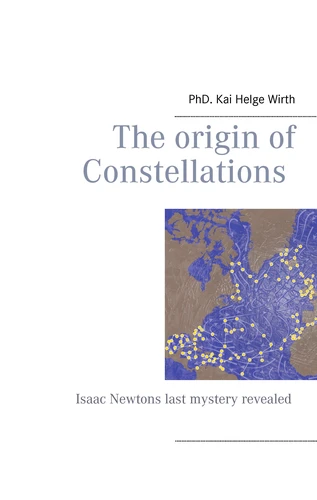The Origin of Constellations. Isaac Newtons last mystery revealed
Par :Formats :
Disponible dans votre compte client Decitre ou Furet du Nord dès validation de votre commande. Le format ePub est :
- Compatible avec une lecture sur My Vivlio (smartphone, tablette, ordinateur)
- Compatible avec une lecture sur liseuses Vivlio
- Pour les liseuses autres que Vivlio, vous devez utiliser le logiciel Adobe Digital Edition. Non compatible avec la lecture sur les liseuses Kindle, Remarkable et Sony
 , qui est-ce ?
, qui est-ce ?Notre partenaire de plateforme de lecture numérique où vous retrouverez l'ensemble de vos ebooks gratuitement
Pour en savoir plus sur nos ebooks, consultez notre aide en ligne ici
- Nombre de pages80
- FormatePub
- ISBN978-3-7431-4505-4
- EAN9783743145054
- Date de parution28/09/2016
- Protection num.Digital Watermarking
- Taille6 Mo
- Infos supplémentairesepub
- ÉditeurBooks on Demand
Résumé
With this publication the author will reveal a fascinating prehistoric system of orientation that has existed over thousands of years, a system that has constantly been visible but could no longer be identified or decoded.
Sir Isaac Newton himself was the first scientist who attempted to solve this mystery. However, it wasn't until the beginning of the 21st century that the German geographer and artscientist, Kai-Helge Wirth finally fullfilled Sir Isaac's quest.
Wirth assembled all available sources about the origins of the star constellations in his work "Chronologia" and examined texts by Appolonius, Exodus and others in great detail. Newton reached the following conclusion: the star constellations were not a natural phenomenon, visible to anyone, who gazes at the sky - but, rather designs, created by seafarers, as an aid in orientation. Chiron, the teacher of the Argonauts drew up a map of the 48 constellations as we know them today.
After that it was Musaios, helmsman (navigator) of the seagoing ship ARGO, who transferred Chiron's constellations to a 3-D globe. This is identical with Isaac Newton's discoveries. The images of the star maps add up to a concrete map of the world and, the constellations are shaped and arranged to represent the world's currents in minute detail. Neighboring images show neighboring currents. This opens surprising insight into the wide range of prehistoric knowledge and the communication horizon of ancient mankind.
Wirth assembled all available sources about the origins of the star constellations in his work "Chronologia" and examined texts by Appolonius, Exodus and others in great detail. Newton reached the following conclusion: the star constellations were not a natural phenomenon, visible to anyone, who gazes at the sky - but, rather designs, created by seafarers, as an aid in orientation. Chiron, the teacher of the Argonauts drew up a map of the 48 constellations as we know them today.
After that it was Musaios, helmsman (navigator) of the seagoing ship ARGO, who transferred Chiron's constellations to a 3-D globe. This is identical with Isaac Newton's discoveries. The images of the star maps add up to a concrete map of the world and, the constellations are shaped and arranged to represent the world's currents in minute detail. Neighboring images show neighboring currents. This opens surprising insight into the wide range of prehistoric knowledge and the communication horizon of ancient mankind.
With this publication the author will reveal a fascinating prehistoric system of orientation that has existed over thousands of years, a system that has constantly been visible but could no longer be identified or decoded.
Sir Isaac Newton himself was the first scientist who attempted to solve this mystery. However, it wasn't until the beginning of the 21st century that the German geographer and artscientist, Kai-Helge Wirth finally fullfilled Sir Isaac's quest.
Wirth assembled all available sources about the origins of the star constellations in his work "Chronologia" and examined texts by Appolonius, Exodus and others in great detail. Newton reached the following conclusion: the star constellations were not a natural phenomenon, visible to anyone, who gazes at the sky - but, rather designs, created by seafarers, as an aid in orientation. Chiron, the teacher of the Argonauts drew up a map of the 48 constellations as we know them today.
After that it was Musaios, helmsman (navigator) of the seagoing ship ARGO, who transferred Chiron's constellations to a 3-D globe. This is identical with Isaac Newton's discoveries. The images of the star maps add up to a concrete map of the world and, the constellations are shaped and arranged to represent the world's currents in minute detail. Neighboring images show neighboring currents. This opens surprising insight into the wide range of prehistoric knowledge and the communication horizon of ancient mankind.
Wirth assembled all available sources about the origins of the star constellations in his work "Chronologia" and examined texts by Appolonius, Exodus and others in great detail. Newton reached the following conclusion: the star constellations were not a natural phenomenon, visible to anyone, who gazes at the sky - but, rather designs, created by seafarers, as an aid in orientation. Chiron, the teacher of the Argonauts drew up a map of the 48 constellations as we know them today.
After that it was Musaios, helmsman (navigator) of the seagoing ship ARGO, who transferred Chiron's constellations to a 3-D globe. This is identical with Isaac Newton's discoveries. The images of the star maps add up to a concrete map of the world and, the constellations are shaped and arranged to represent the world's currents in minute detail. Neighboring images show neighboring currents. This opens surprising insight into the wide range of prehistoric knowledge and the communication horizon of ancient mankind.












